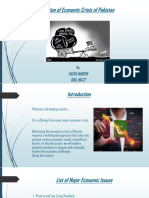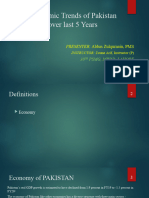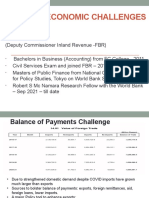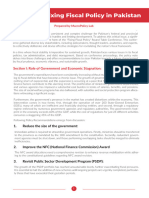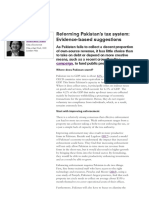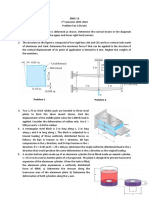Lecture Economy 2
Uploaded by
ayeshasiddiqa.9525Lecture Economy 2
Uploaded by
ayeshasiddiqa.9525Current Affairs with Sir Usman (PAS) 9/24/2024
Agenda of
reforms
How to overcome the dilemma
of Current Account deficit
Or
How to lessen the issue of
external vulnerabilities
0314-4600454 1
Current Affairs with Sir Usman (PAS) 9/24/2024
1. Promoting skilled workers outflow
• The country received $150 billion in remittances
during the five years from 2017 to 2022 and was
ranked fifth among the top remittances-receiving
countries in 2022. (Saleh Kamel Islamic Economy
Database)
• Changing global landscape:
Russia Ukraine war dampens trade, Middle East
Quagmire,
• Learning from India’s experience: Sending trained
workforce abroad
2. Attracting FDIs
• A streamlined, one-window operation for company setup
• Sustainable and consistent industrial policies
• Active marketing and promotion of Pakistan as an investment destination
• Suggestions:
Provide import tax concessions for SEZs
One window operation
Administrative autonomy with regulatory framework: As per section 27 (i) of the SEZ Act, it is the
responsibility of the provincial and federal government to ensure the provision of utilities to each SEZ.
Fast tracking of SEZs already established under CPEC through SIFC
0314-4600454 2
Current Affairs with Sir Usman (PAS) 9/24/2024
• Case study: Learning from China
FDI inflows surged from almost negligible in 1970s to $186 billion in 2022.
After economic reforms in 1978, China established a number of Special Economic
Zones (SEZs). These zones were given autonomy in their investment decisions with
tax and tariff concessions, preferential income tax treatment and exemptions from
import licenses.
Besides, China Council for International Investment Promotion (CCIIP) was
established
Presently, it takes 256 days for a foreign company to establish a set up in Pakistan
and complete all processes involving several institutions i.e. Board of Investment
(BOI), Securities and Exchange Commission of Pakistan (SECP), Federal Board of
Revenue (FBR), State Bank of Pakistan (SBP) and relevant regulatory bodies.
3. Curbing food import bill
• Pakistan imports 75% of its Palm oil from Indonesia and 25% from Malaysia
under the Preferential Trade Agreement and Free Trade Agreement,
respectively
Over 88 percent of the total edible oil is imported in Pakistan, leading to
substantial foreign exchange expenditure.
0314-4600454 3
Current Affairs with Sir Usman (PAS) 9/24/2024
4. Reviving exports
Low • Furniture, footwear, synthetic textiles
hanging and garments, food processing, surgical,
(short term) electronics assembly
Balanced
• Steel, Non-ferrous metals, Mining,
(medium
Petrochemicals, Electronics
term)
• Platform changing value chains (EV,
decentralized power storage, batteries),
Strategic
Clean Tech, Electronics (cell phones etc.),
(long term)
Electrical Machinery, IoT, Autonomous
vehicle
Diversification
Exports Output Quality
diversification Diversification upgradation
Across Existing
Across sectors
products products
Across
partners
Across services
0314-4600454 4
Current Affairs with Sir Usman (PAS) 9/24/2024
The IT
potential?
Case study of India:
• IT exports surpassing $250 billion today.
• For example, Apple assembled $14 billion worth of iPhones in India in fiscal
2024, Bloomberg News reported earlier this year.
0314-4600454 5
Current Affairs with Sir Usman (PAS) 9/24/2024
Gearing up Industrialization
1. South Korea's 4. Singapore's
2. China's Industrial 3. Germany's Dual 5. Turkey's Mixed
Export-Oriented Knowledge-Based
Cluster Model: Education Model: Economy Model:
Model: Economy Model:
•Pakistan's textile and •The Rashakai SEZ and •Implementing a dual •Lahore Knowledge •Pakistan’s existing
agriculture sectors can Faisalabad SEZ reflect education system is Park represents a step SEZs already
benefit from this model, efforts to create essential to address toward a knowledge- incorporate public-
especially in SEZs like specialized clusters. Pakistan's skills gap, based economy. But, private collaboration.
the Quaid-e-Azam However, unlike China, especially in Pakistan's innovation However, Pakistan
Apparel Park and Pakistan faces manufacturing and ecosystem is still must ensure more
Karachi Export challenges such as IT/ITES sectors within nascent, with limited effective management
Processing Zone. inconsistent policies, SEZs. However, this R&D funding and weak and accountability in
However, achieving the inadequate requires cooperation links between academia state-owned enterprises
same level of infrastructure, and between industries and and industry. The and create a more
technological energy shortages. educational government needs to business-friendly
advancement as South Overcoming these institutions, which may gradually build this regulatory
Korea requires issues will require be a long-term goal model by incentivizing environment, balancing
significant investment focused policy given current R&D, developing government
in infrastructure, continuity, better institutional stronger intellectual involvement with
energy, and power supply, and limitations and the property laws, and private sector
technological targeted investment need for significant fostering university- incentives.
upgradation, which rather than expecting curriculum overhaul. industry partnerships.
may be gradual due to rapid transformation.
financial constraints.
Pakistan's capacity to mobilise taxes is greatly under-explored. With a tax-to-
GDP ratio of 8.5% along with an undeclared economy almost the size of the
official economy, the potential for tax collection is astronomical. With an
estimated total economy twice the size of Rs1,000 trillion official economy at
a modest tax collection of 16% puts a revenue of Rs 32,000 billion in sight,
compared with the paltry Rs 9,400 billion being collected. Why, then, is
Pakistan unable to collect the fair share of taxes its economic activity can
generate?
0314-4600454 6
Current Affairs with Sir Usman (PAS) 9/24/2024
Efforts should include:
Reducing distortive exemptions
Tapping new tax bases in agriculture and land
Simplifying compliance for the taxpayer.
Special Investment Facilitation Council (SIFC) has finalized a digitization and
restructuring plan of the Federal Board of Revenue (FBR) …removing obstacles to tax
collection and improving the efficiency of the tax machinery. Tax revenue collection will be
increased to 18 percent of GDP by 2029 from the current level of 8.5 percent
Recommendations to broaden tax
net(WORLD BANK)
1. Improving federal-provincial coordination is critical.
coordination of tax bases
creating a single tax market
reducing the number of required interactions between taxpayers and revenue authorities
Ongoing digitization efforts should be accelerated to reduce compliance costs and minimize the need for
interactions between taxpayers and collectors. This should include faster progress with:
(i) data sharing between tax agencies
(ii) making mandatory use of Computerized National Identity Cards (CNIC) for transactions, particularly of assets
(iii) development of a single portal for the sales tax
) digitization of land records and digital imagery of urban and rural lands.
0314-4600454 7
Current Affairs with Sir Usman (PAS) 9/24/2024
Federal level
• 2. closing exemptions, simplifying the tax structure, and raising new
revenues through excises.
Close corporate tax exemptions.
this could include exemptions for power generation projects, which amounted to PKR 37
billion in FY21 and exemptions for real estate investments, which amounted to PKR 26
billion. Savings would be sufficient to fund 35,000 teachers on the average public sector
salary, over two-thirds of Balochistan’s teacher population
Increase excise duties on socially harmful goods.
Reduce tax expenditures in the energy sector and for COVID-19 response.
3. Close exemptions for basic household items.
Removing exemptions for food items including oil, pulses, animal, fruit, and dairy, could save
PKR100 billion in revenues. Current concessionary rates on fertilizer impose fiscal costs of
PKR 90 billion..!!!!!
At the provincial level
3. improving own source revenue and accountability, including taxation of land and
agriculture income.
• Provincial governments can significantly increase revenues through improved, increased and
progressive agricultural income taxation
• Reforms to:
• ensure appropriate categorization of land—taking account of size, location irrigation status, and area-based productivity
aspects into tax rates. Simulations of an acreage-based tax indicated potential to generate additional provincial
revenues of around one percent of GDP.
• Provincial governments can significantly increase taxation of land.
• generating up to two percent of GDP in revenues:
i) continue or complete the establishment of reliable records of land ownership linked to NCICs and TINs;
iii) increase property tax rates to match those applied in peer economies
iv) improve the policy and legal framework to ensure that sizable and growing peri-urban settlements outside current
notified municipal boundaries are also subject to appropriate land taxation.
0314-4600454 8
Current Affairs with Sir Usman (PAS) 9/24/2024
Conti…
4. Reforms to current fiscal institutional arrangements should be pursued over the
medium-term.
Over the medium-term, GST administration responsibilities should be consolidated with a
single agency.
Federal and Provincial governments could agree to the establishment of a single administration,
Revenues collected by the consolidated tax authority would continue to be distributed according to the 18th
Amendment.
5. Reforms to grow the economy and encourage formalization will also support
sustainably higher revenues.
Pakistan’s revenue potential is limited by the current structure of its economy.
broader measures to encourage investment, economic growth, and formalization, including through reforms to
improve the business enabling environment, remove the anti-export bias in trade policies, and reduce the
presence of the state within the economy
FBR related measures
discourage parking
of black money in • FBR values should reflect the market values
real estate
• FBR should be empowered to coordinate with utility
companies, banks, registrar of properties etc., to identify
identify potential tax evaders.
tax payers and • NADRA and other databases/sources of information
make it expensive should be mined and AI deployed to expand the tax net.
for them to remain • The rates of advance tax for those industrial and
outside the tax base commercial customers who are not registered for sales tax
should be increased to 20%. The same differential should
apply to Gas bills.
To make it • Tax returns and processes should be simplified and
attractive to join digitized. Personal interface between tax payers and tax
the tax base and officers should be minimized
easier to file tax
returns
0314-4600454 9
Current Affairs with Sir Usman (PAS) 9/24/2024
Transfer management to private investors
The chaotic pursuit of privatisation of cash-bleeding
SEOs
The massive annual losses of Rs500 billion incurred by the SOEs, which form a part of
growing public expenditure, have become a major drag on the national budget, with
their accumulated losses topping Rs2.5 trillion or nearly $9bn. Moreover, the financial
burden of these resource-guzzlers, apart from haemorrhaging government budgets,
has also become a source of systemic risk for the financial sector.
The current privatisation list focuses on loss-making public enterprises and prioritises entities like PIA
and power distribution companies to reduce the government’s involvement and haemorrhage of taxpayers’
money.
“the profitability of Pakistan’s federal SOEs is the lowest in the South Asian Region” as their aggregate
profit at 0.8 per cent of GDP in 2014 turned into losses worth 0.4pc of GDP in 2020 and, growing, thus
becoming a major driver of fiscal deficit and source of substantial fiscal risk. (WORLD BANK)
0314-4600454 10
Current Affairs with Sir Usman (PAS) 9/24/2024
STEPS TAKEN:
The current privatisation initiative, undertaken under the army-backed Special
Investment Facilitation Council (SIFC), aims to sell shares of certain public assets to
investors from friendly Gulf countries.
The authorities expect a massive investment of more than $50bn from the United Arab Emirates
(UAE) and Saudi Arabia alone over the next five years. So far, however, only a fraction of the
investment has been made by investors from these two countries in Karachi Port and a private
oil marketing company.
Privatisation of loss-making public entities and improvements in the governance of
others are also major goals of the ongoing International Monetary Fund (IMF) rescue
loan as part of structural reforms.
IMF wants early privatisation of PIA, Pakistan Steel Mills, RLNG power plants, and electricity
distribution companies.
BENEFITS of privatisation of SEOs
• Pakistan started privatisation of the state-owned enterprises in the late 1980s under the IMF’s
Structural Adjustment Programme (SAP) when the first Benazir Bhutto government offloaded
15pc shares of PIA through the stock exchange. The privatisation transactions have
returned a gross value of Rs650bn (approximately $2.36bn) to the government during
the last three decades.
• The privatisation of banks, the telecom industry, and electronic media is often
underlined as huge success stories that must encourage policymakers to disinvest the
remaining SOEs to save taxpayers’ money, improve efficiency, create more market
competition, and encourage greater private sector investment and participation in
the economy.
0314-4600454 11
Current Affairs with Sir Usman (PAS) 9/24/2024
The hurdles in the privatization
process:
• The authorities must consult widely and involve professionals AND regulators should be
made independent
• economic volatility, judicial activism and resistance from trade unions, litigation,
fears of monopoly creations, weak political commitment, and perceptions of
corruption cost post-2007 as key factors leading to unsuccessful privatisation
efforts. WORLD BANK
“Judicial decisions in the Pakistan Steel Mills privatisation and Reko Diq mining contract cases
badly hurt Pakistan’s image as an untrustworthy country where international contracts are not
honoured, and businesses always run the risk of falling victim,” -WORLD BANK
Some other major
reforms
0314-4600454 12
Current Affairs with Sir Usman (PAS) 9/24/2024
Refocusing on strategic Investing on human
Back to agriculture:
development projects: capital:
• augmentation of water • Overall, almost 46 • According to the latest
resources through early percent of the economy UNDP Global Human
completion of dams and of Pakistan is directly or Development Report.
on investment in indirectly dependent on The HDI of Pakistan is
upgrading and agriculture 0.544 and it is ranked
modernizing the • The ‘back to agriculture’ 161st out of 191
electricity distribution slogan: countries
system • Increasing import • India 132nd,
duty: currently it is Bangladesh 129th
13pc. In India it is
34pc.
• Dropping price
support mechanism for
sugar and continuing
it for cotton
Management of the Power Sector
• The following options may be explored.
i) Privatization of DISCOs. The experience with K-Electric needs to be reviewed.
ii) Provincialization of DISCOs.
iii) Handing back power distribution to WAPDA as was the case up the mid-90’s,
which will also facilitate power sector vertical integration.
0314-4600454 13
Current Affairs with Sir Usman (PAS) 9/24/2024
Exploring Blue Economy Potential
• In the wake of the pandemic's devastating impact on livelihoods,
employment, and supply chains, the Blue Economy has emerged as a critical
focus for sustainable economic activity. The Blue Economy encompasses a
wide range of areas, such as marine affairs, offshore hydrocarbons,
renewable energy, food security, energy security, climate change, ocean
conservation, refugees at sea, oil spills and the environment, gender
equality, tourism, maritime law, shipping regulations, sustainable
development goals, international maritime organizations, shipyards,
desalination, coastal wastewater treatment, inland waterways, port and
shipping digitization, geopolitics, economic zones, water sports, healthcare,
and fishing.
• Pakistan's extensive coastline of 1,046 kilometers and its 240,000-
square-kilometer Exclusive Economic Zone (EEZ) in the Arabian
Sea provide abundant marine biodiversity, offering significant
opportunities for sustainable development and economic prosperity
through the blue economy
0314-4600454 14
Current Affairs with Sir Usman (PAS) 9/24/2024
Papt papers question
• CSS 2023
0314-4600454 15
You might also like
- Economics of Pakistan-A Realistic Non-Political Analysis & Common Minimum Economic ProgramNo ratings yetEconomics of Pakistan-A Realistic Non-Political Analysis & Common Minimum Economic Program27 pages
- 3rd Interdepartmental Policy Making Competition 2025No ratings yet3rd Interdepartmental Policy Making Competition 202544 pages
- Economic Problems and Solutions For PakistanNo ratings yetEconomic Problems and Solutions For Pakistan9 pages
- Lecture No 7-Economic Conditions, Challenges and Problems of Pakistan-1No ratings yetLecture No 7-Economic Conditions, Challenges and Problems of Pakistan-127 pages
- Pakistan Economy Review and Recommendations - 9No ratings yetPakistan Economy Review and Recommendations - 923 pages
- 4, Economic Crisis Challenges and SolutionsNo ratings yet4, Economic Crisis Challenges and Solutions5 pages
- Our Publications:: Chapter 7: Preparing For The Next Wave of Developments Under CPECNo ratings yetOur Publications:: Chapter 7: Preparing For The Next Wave of Developments Under CPEC9 pages
- Economic Conditions and Challenges of Pakistan (2020 to 1st Jan 2025)No ratings yetEconomic Conditions and Challenges of Pakistan (2020 to 1st Jan 2025)5 pages
- Issues in Pakistan Economy: Topics Source Sections (1) Idea of DevelopmentNo ratings yetIssues in Pakistan Economy: Topics Source Sections (1) Idea of Development3 pages
- RR Immediate Reform Agenda Imf and BeyondNo ratings yetRR Immediate Reform Agenda Imf and Beyond101 pages
- NF Econ NF6013 Individual Assignment Submission_Vikas Kumar_G2400256GNo ratings yetNF Econ NF6013 Individual Assignment Submission_Vikas Kumar_G2400256G12 pages
- Futuristic_Outlook_of_Pakistan_Thematic.pptx_20250131_195956_0000No ratings yetFuturistic_Outlook_of_Pakistan_Thematic.pptx_20250131_195956_000017 pages
- Revitalising Pakistan’s economy - Newspaper - DAWN.COMNo ratings yetRevitalising Pakistan’s economy - Newspaper - DAWN.COM5 pages
- Economic Challenges of Pakistan SP 24 BookNo ratings yetEconomic Challenges of Pakistan SP 24 Book3 pages
- Why Do We Nation Fail?: Economic Development: Pakistan, A Nation Located in South Asia, HasNo ratings yetWhy Do We Nation Fail?: Economic Development: Pakistan, A Nation Located in South Asia, Has22 pages
- Talking Points For Launching Ceremony of Pakistan Economic Survey 2023-24No ratings yetTalking Points For Launching Ceremony of Pakistan Economic Survey 2023-2413 pages
- Textual Insights Into Economic NarrativesNo ratings yetTextual Insights Into Economic Narratives20 pages
- Shabbar Z - Pakistan Ecnomic Policies 2008-2009No ratings yetShabbar Z - Pakistan Ecnomic Policies 2008-200926 pages
- Salient Features of Budget 2014-15 of PakistanNo ratings yetSalient Features of Budget 2014-15 of Pakistan13 pages
- Wani Reforming Pakistans Tax System PublishedNo ratings yetWani Reforming Pakistans Tax System Published3 pages
- Policies to Support the Development of Indonesia’s Manufacturing Sector during 2020–2024: A Joint ADB–BAPPENAS ReportFrom EverandPolicies to Support the Development of Indonesia’s Manufacturing Sector during 2020–2024: A Joint ADB–BAPPENAS ReportNo ratings yet
- Reforms, Opportunities, and Challenges for State-Owned EnterprisesFrom EverandReforms, Opportunities, and Challenges for State-Owned EnterprisesNo ratings yet
- Inclusive Design Design For The Whole Population 1st Edition Roger Coleman pdf download100% (1)Inclusive Design Design For The Whole Population 1st Edition Roger Coleman pdf download29 pages
- 01- FDC Fire Department Conniction, Straight Single Clapper Two-way Inlets 4 inch, Giacomini, Model A95No ratings yet01- FDC Fire Department Conniction, Straight Single Clapper Two-way Inlets 4 inch, Giacomini, Model A951 page
- Technical Data Sheet - TheRMOFIL PP F820R00 Natural-Sumika Polymer Compounds Ltd. (2017)No ratings yetTechnical Data Sheet - TheRMOFIL PP F820R00 Natural-Sumika Polymer Compounds Ltd. (2017)2 pages
- Experiment Three: Distillations Part One - Simple Distillations DiscussionNo ratings yetExperiment Three: Distillations Part One - Simple Distillations Discussion18 pages
- Ae 1408 Coresense Communications For 13 To 15 Ton Copeland Scroll Air Conditioning Compressors en 5237224No ratings yetAe 1408 Coresense Communications For 13 To 15 Ton Copeland Scroll Air Conditioning Compressors en 523722419 pages
- Schenk DatingHistoricalValueRoulettedWareNo ratings yetSchenk DatingHistoricalValueRoulettedWare30 pages
- Plan of The Physics Lab Report - Ravin Chaudhary - 9INo ratings yetPlan of The Physics Lab Report - Ravin Chaudhary - 9I8 pages
- Joshi 等 - 2020 - A 5.6 μ A Wide Bandwidth, High Power Supply RejectNo ratings yetJoshi 等 - 2020 - A 5.6 μ A Wide Bandwidth, High Power Supply Reject10 pages
- British Nova Product Guide For Novashield: Metallised Floor DressingNo ratings yetBritish Nova Product Guide For Novashield: Metallised Floor Dressing2 pages
- Cambridge International AS & A Level: Geography 9696/11No ratings yetCambridge International AS & A Level: Geography 9696/1119 pages
- For The Poly Furniture Factory Example in Lab 4, Section L4.3100% (1)For The Poly Furniture Factory Example in Lab 4, Section L4.38 pages
- You Must Do It: Must Must Obligation Must Not Don't Be Careful Warning ProhibitionNo ratings yetYou Must Do It: Must Must Obligation Must Not Don't Be Careful Warning Prohibition2 pages
- Pharmacology Mind Maps for Medical Students and Allied Health Professionals 1st Edition by Prasan Bhandari ISBN 1138351245 9781138351240 - The latest ebook is available, download it today100% (6)Pharmacology Mind Maps for Medical Students and Allied Health Professionals 1st Edition by Prasan Bhandari ISBN 1138351245 9781138351240 - The latest ebook is available, download it today85 pages
- DM74LS03 Quad 2-Input NAND Gates With Open-Collector OutputsNo ratings yetDM74LS03 Quad 2-Input NAND Gates With Open-Collector Outputs4 pages
- Therapeutic Effectiveness of Instrument-Assisted Soft Tissue Mobilization For Soft Tissue Injury - Mechanisms and Practical ApplicationNo ratings yetTherapeutic Effectiveness of Instrument-Assisted Soft Tissue Mobilization For Soft Tissue Injury - Mechanisms and Practical Application20 pages




































